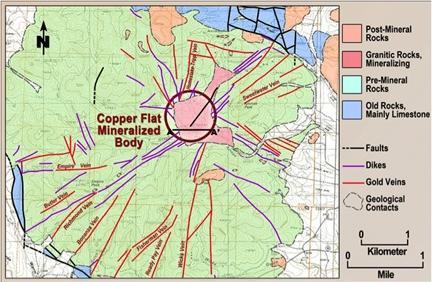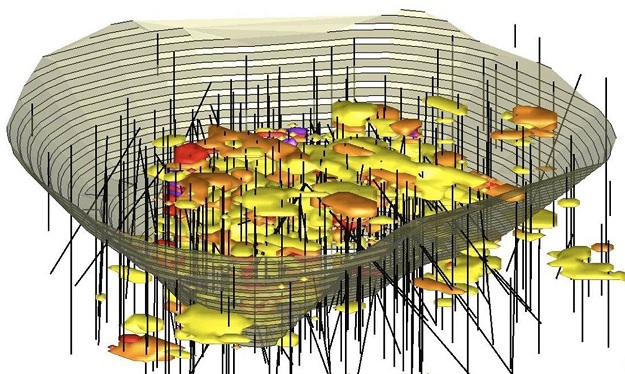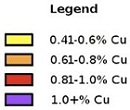Exploration & Geology
Geology
In 1905, the world’s first open pitiable, low-grade copper porphyry started production at Bingham Canyon Mine. Today, disseminated copper deposits and their associated hydrothermal systems contribute significantly towards world copper production. They account for more than 50% and over 95% of the world’s copper and molybdenum supply, respectively. Most porphyry systems also produce gold and silver as a byproduct, with ranges varying from 0.004 to 0.35 g/t Ag and 0.2 to 5 g/t Au. In 2007 the USA alone supplied up to 8% of the world’s copper demand, with the state of New Mexico ranked by the U.S. Geological Survey (USGS) as the third largest USA supplier. Copper porphyry deposits are globally restricted to two types of orogenic belts: those created along a subduction zone (where a continental and ocean plate meet) and those found along island arcs (where two oceanic plates collide). Porphyry deposits discovered along the coast of South America and North America are examples of porphyry deposits fashioned by a subduction setting. During the 1990s, through ongoing studies, the USGS concluded that approximately 350 million tons of copper had been discovered in the USA, and that about 290 million tons remained undiscovered.
The Copper Flat Project, located in the Las Animas Mining District in South Central New Mexico, in the County of Sierra, USA, has a rich mining history stretching back to the late 19th Century. Modern exploration for porphyry copper mineralization was first initiated during the early 1950s and since, has been the primary focus within the district for many companies, including THEMAC Resources. Today, the Copper Flat Project is an advanced porphyry copper and molybdenum project. Extensive exploration has resulted in a clear understanding of mineralization distribution. The deposit is situated within a 4 mile wide stratovolcano complex with accompanying andesites and an intruded quartz-monzonite stock, known as Copper Flat Stock. Current indications suggest that Copper Flat Stock is an alkali Cu-Au mineralized breccia pipe, associated with, and genetically linked to an alkali porphyry system at depth. Breccia pipe mineralization accounts for approximately one-third of the resource. One-half of the contained copper and molybdenum is located within this mineralized structure. 
Copper mineralization at Copper Flat is mostly unoxidized. It occurs in a hypogene sulfide environment largely in the form of copper-iron-sulphide or Chalcopyrite, which is hosted in the core of a breccia pipe. This style of mineralization and the associated alteration are broadly similar to other hydrothermal porphyry copper deposits in the southwest United States. Other mineralization associated with Copper Flat includes molybdenum, lead and zinc. Molybdenite (molybdenum sulphide) when present, occurs either in quartz veins, or as thin coatings in fractures. Sphalerite (zinc-iron-sulphide) and Galena (lead-sulphide) occur within the stock in minor amounts as carbonate and quartz veins associated with more dominant pyrite (iron-sulphide).
Exploration
Exploration activities at Copper Flat have developed since the 1980s. Recent exploration completed by THEMAC personnel included detailed surface mapping of all exposures within the historical pit, drainage cuts, and most of the outlying Project, covering a total area of 4,701 acres.
Extensive geochemical sampling was also completed to improve the understanding of the precious metal distribution outside of the deposit, as well as identifying other potential exploration targets.
During a recent drilling program twenty core holes totaling 22,369.5’ were completed, as well as five geotechnical core holes totaling 3,609’. All core was split and assayed and the results were incorporated into the latest reserve and resource model for the Feasibility Study.
In addition to drilling and reconnaissance, the entire historical core has been re-logged to obtain lithological and structural information using core photographs. Additional mineralogical and metallurgical studies have been undertaken and geotechnical studies have been completed. A CSAMT geophysical survey was completed in the central part of the project to investigate and define the extent of the CFQM and sulfide mineralization.
Following completion of the 2012 drilling program, the footprint of the Copper Flat deposit is now considered fully defined for the purpose of the Feasibility Study. There is potential to futher expand the known copper reserve and resource base through additional drilling. Any drilling undertaken will be focused on attempting to extend the deposit at depth (below the bottom of the planned pit). The margins of the deposit and in particular the northeastern lobe of the deposit will also be drill tested.
3-D Grade Model

